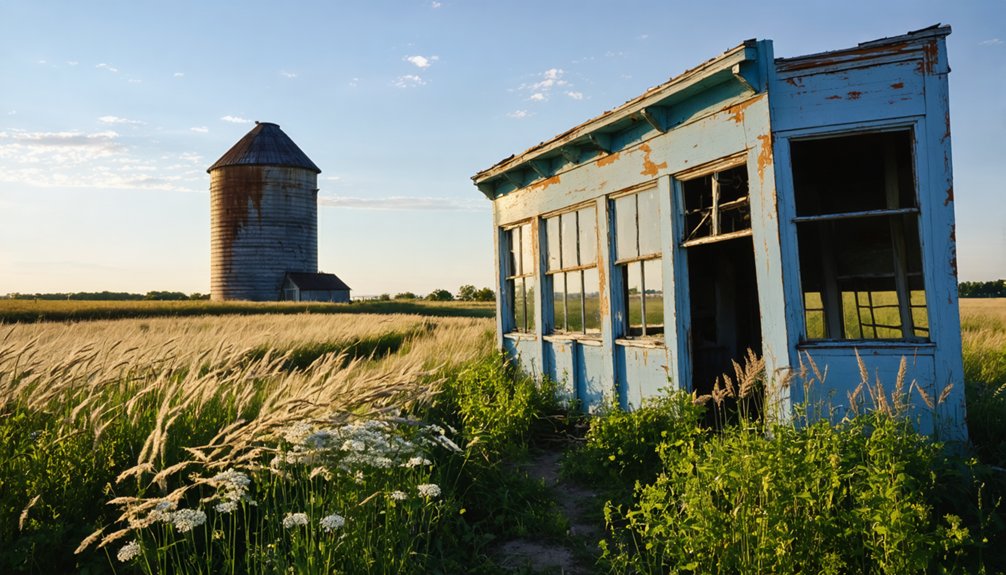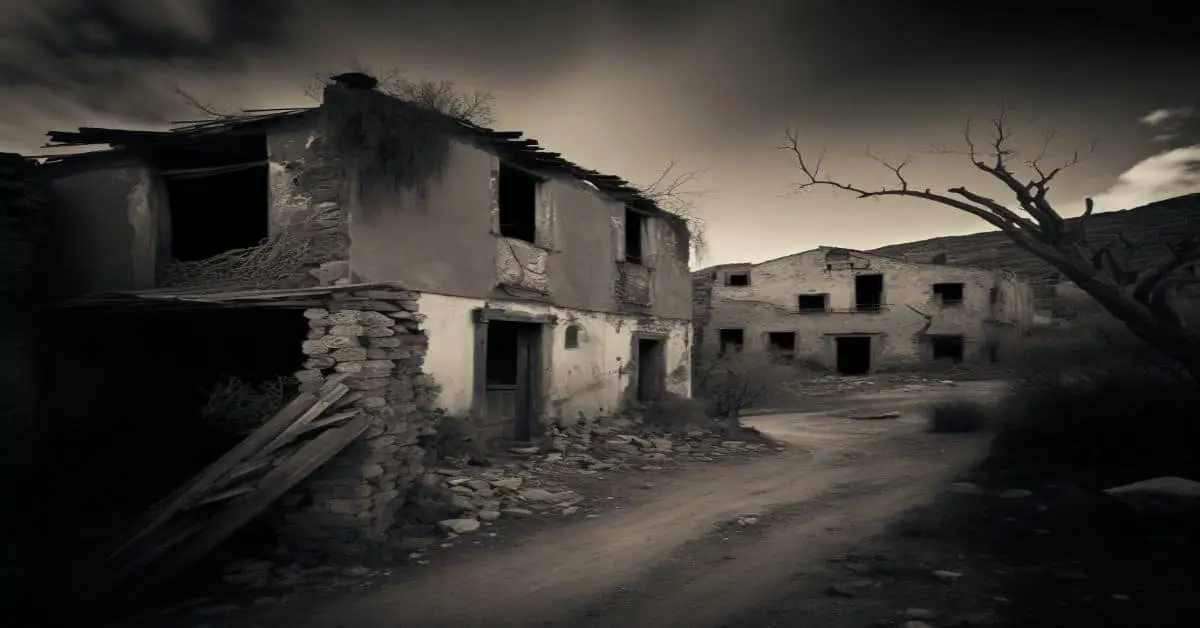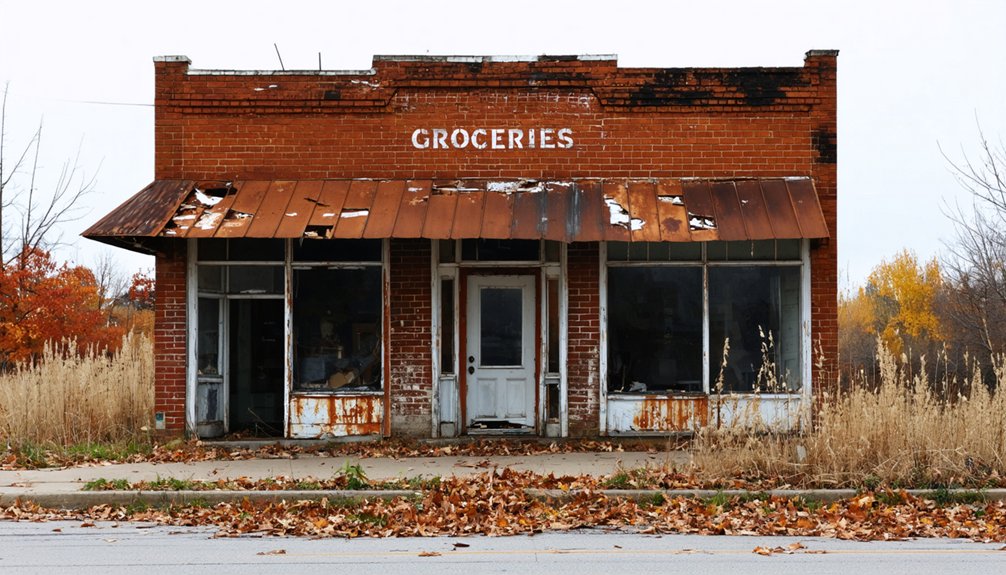You’ll find Midway located 5.5 miles southeast of Iowa City at coordinates 41.61889°N, 91.43917°W, at an elevation of 686 feet. This former Johnson County settlement flourished as an agricultural hub from 1837 until the early 1900s, reaching its peak population of 597 residents in 1902. While no physical structures remain today, Midway’s strategic position along regional trade routes and its role in early Iowa development tell a fascinating story of boom-and-bust settlement patterns.
Key Takeaways
- Midway was established in Johnson County, Iowa in the mid-19th century, located 5.5 miles southeast of Iowa City at 41.61889°N, 91.43917°W.
- The town reached its peak population of 597 residents in 1902, functioning as an agricultural settlement and transportation hub.
- Economic decline began after 1902 when railroads consolidated operations and automobiles became more prevalent in the 1920s-30s.
- The community failed to adapt to changing transportation patterns, leading to rapid abandonment and eventual ghost town status.
- No physical evidence of Midway remains today, making it a true ghost town in Johnson County’s historical landscape.
Early Settlement and Founding Years
While Johnson County was established by the Wisconsin Territory legislature in December 1837, the settlement of Midway emerged during the mid-19th century about 5.5 miles southeast of Iowa City.
As part of the county’s settlement history, Midway’s founding significance was tied to the region’s expanding agricultural development and transportation networks. The area saw rapid growth similar to other parts of the county, with the population increasing from 200 in 1838 to substantial numbers in subsequent decades.
Like other communities of its era, Midway’s location was strategically chosen, likely influenced by access to transportation routes that were crucial for trade and communication in the developing territory.
The settlement grew steadily, reaching a population of 597 by 1902.
You’ll find that Midway’s early growth paralleled the broader development patterns of Johnson County, which initially operated under Cedar County’s governance until establishing its own civil structure.
To help modern researchers locate information about the historic settlement, Midway is listed on Wikipedia’s disambiguation page to distinguish it from other locations sharing the same name.
Geographic Location and Natural Features
You’ll find Midway’s historic location approximately 5.5 miles southeast of Iowa City at coordinates 41.61889°N, 91.43917°W in Johnson County, Iowa.
The ghost town site, now on private property, sits at an elevation of 686 feet above sea level amidst the rolling agricultural landscape typical of southeastern Iowa. Like the strategic position of its Pacific namesake, this Iowa settlement was positioned at a key crossroads connecting early regional trade routes.
The surrounding terrain consists primarily of fertile farmland, though no major waterways or rivers flow directly through the former settlement’s immediate vicinity.
River Landing Position
Located southeast of Iowa City at coordinates 41°37′08″N 91°26′21″W, the ghost town of Midway sits at an elevation of 686 feet above sea level in Johnson County’s Scott Township.
While some ghost towns developed around river transportation networks, historical records don’t indicate Midway had a direct connection to river landings or water-based commerce. Unlike the prominent Midway Atoll in the Pacific Ocean, this Iowa settlement was an inland location without significant water features.
- You’ll find Midway positioned about 5.5 miles from Iowa City on gently rolling terrain typical of eastern Iowa’s glacial plains.
- The town’s inland location suggests it wasn’t dependent on river transportation for its economic activities.
- No historical documentation mentions docks, landings, or water-related infrastructure at the site.
- The ghost town dynamics indicate Midway functioned primarily as an agricultural settlement rather than a river port, with the surrounding landscape now returned to farmland.
Distance From Iowa City
The ghost town of Midway sits 5.5 miles southeast of Iowa City, nestled within the gently undulating farmland of Johnson County’s Scott Township.
You’ll find it at an elevation of 686 feet above sea level, where the landscape showcases typical Southeast Iowa features including scattered creeks and patches of woodland.
The location’s community connections once thrived along routes designed for horse and carriage travel, though today’s rural accessibility is limited to private farmland.
From Iowa City’s center, you can reach Midway’s former site in under 15 minutes by car, traveling through a shifting zone where urban development gives way to agricultural expanses.
The terrain between the two points offers a gentle journey through rolling hills, without significant elevation changes or geographic barriers.
Coordinates and Boundaries
Situated at 41.6680°N and -91.5870°W, Midway’s former townsite occupies a section of gently rolling terrain within Johnson County’s agricultural heartland. At an elevation of 686 feet, you’ll find this ghost town‘s coordinates significance lies in its strategic position within Iowa’s rich farming region.
The site’s boundary implications are defined by:
- Private property restrictions that limit public access to the former settlement
- Natural features typical of Iowa’s rural landscape, including fertile agricultural lands
- Absence of major water bodies or notable geographical landmarks
- Integration into Johnson County’s broader agricultural framework
While you can’t visit the actual site, you’ll appreciate how Midway’s location exemplifies the geographic patterns common to many of Iowa’s vanished communities, where rural development once flourished.
Transportation Hub and Economic Growth
You’ll find Midway’s economic growth was closely tied to its strategic position along key regional trade routes, including both river landings and railroad connections in Johnson County.
The town’s role as a transport hub meant local businesses could efficiently move agricultural goods and other commodities between Iowa City and surrounding rural areas.
Rail development in the late 19th century particularly boosted Midway’s commercial activity, helping it reach a population of 597 by 1902. However, when new highways bypassed the town in later years, businesses and residents gradually relocated elsewhere.
River Landing Activities
During its peak settlement period, Midway’s strategic location along the Iowa River positioned it as a modest transportation hub, though not as prominent as neighboring Iowa City.
While river commerce wasn’t as reliable due to the Iowa River’s unpredictable nature, the settlement still maintained connections to regional transportation networks. Similar to other Iowa waterways of the era, Native Iowan tribes had established routes along this section of the river. Captain Dan’s steamboat briefly stopped at Midway during its historic 1841 journey.
You’ll find these key aspects of Midway’s river landing activities:
- Local traders utilized small vessels like canoes and flatboats for limited river commerce when conditions permitted.
- The river landing served as a secondary route for agricultural goods transportation, supplementing stagecoach routes.
- Recreational activities along the riverbank provided community gathering opportunities.
- The river landing area supported early settlers’ needs before road infrastructure development gained prominence.
As stagecoaches and eventually railroads became dominant, Midway’s river landing gradually diminished in importance for regional trade.
Rail Development Impact
While records of specific rail branch details remain unconfirmed, Midway’s location 5.5 miles southeast of Iowa City positioned it to benefit from Iowa’s expanding rail network in the late 1800s.
The town’s peak population of 597 in 1902 suggests it flourished as a local transport hub, with rail access enabling agricultural commerce and goods movement.
You’ll find that Midway’s economic dependency on rail transport ultimately contributed to its downfall.
As railroads consolidated operations in the early 20th century and automobiles gained prominence in the 1920s-30s, the town couldn’t adapt to changing transportation patterns.
Without diversifying its economy beyond rail-dependent activities, Midway followed a common pattern of Midwestern ghost towns – rapid abandonment after losing its crucial rail connection, with no structures surviving today.
Regional Trade Routes
Beyond its rail connections, Midway thrived as a strategic transportation nexus along early 19th-century regional roads linking Iowa City to southeastern Johnson County settlements.
You’ll find the town’s trade dynamics were shaped by its position as a vital waypoint for stagecoaches and local travelers, just 5.5 miles from Iowa City.
Key aspects of Midway’s route evolution included:
- Secondary trade routes that fed into main arteries through Johnson County
- Local wagon paths connecting farming communities for livestock and grain transport
- Seasonal trading fairs that stimulated economic growth beyond subsistence farming
- Essential merchant services supporting agricultural expansion throughout the region
The town’s strategic location enabled the aggregation of agricultural goods for shipment to larger markets, particularly Iowa City, making it an important node in the area’s commercial network.
Peak Population and Community Life
Midway reached its population zenith in 1902 with 597 residents, establishing itself as a notable small community within Johnson County’s Scott Township. You’d have found a bustling rural settlement where neighbors gathered for community events and supported local businesses, schools, and churches.
The town’s social fabric centered around agricultural practices typical of early 20th-century Iowa. Records from this era are carefully maintained in the county disambiguation pages, helping preserve the history of towns like Midway. At its peak, Midway offered the essential services you’d expect in a Midwestern town of that era, including a post office and basic civic amenities.
Life revolved around interconnected families who worked the land and maintained strong community bonds. While no catastrophic event led to its decline, the town gradually lost population as economic opportunities shifted elsewhere, eventually becoming the ghost town you’ll find today.
Notable Buildings and Infrastructure
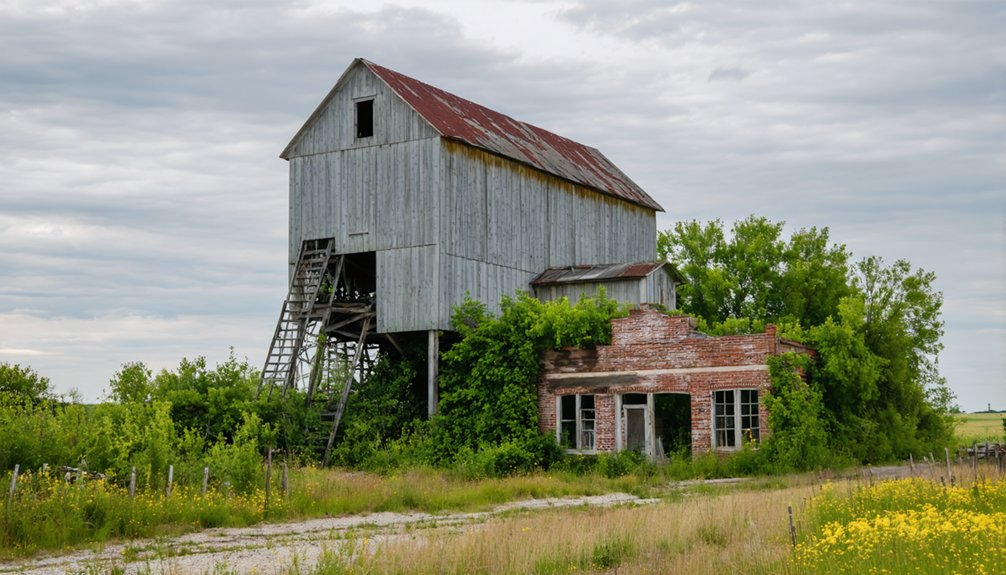
Today, you’ll find no physical reminders of Midway’s existence at its original site, located 5.5 miles southeast of Iowa City.
Time and progress have erased all traces of Midway, leaving only memories where a community once stood southeast of Iowa City.
This ghost town has completely vanished into Iowa’s agricultural landscape, leaving no architectural significance behind for modern explorers to discover.
Historical records suggest Midway once featured:
- A general store serving the rural community’s daily needs
- A schoolhouse where local children gathered for education
- Several residential homes typical of 19th-century Iowa settlements
- Basic road connections linking to Iowa City
Unlike other abandoned towns that might retain foundations or a lone church steeple, Midway’s infrastructure has been entirely reclaimed by nature and farming.
The site relied on wells for water, and without railway access, the community remained relatively isolated until its eventual abandonment.
Decline and Abandonment
After reaching its peak population of 597 residents in 1902, the settlement experienced a steady decline that would ultimately lead to its complete abandonment.
While specific population factors contributing to Midway’s demise aren’t fully documented, the absence of rail connections and major highways likely accelerated the town’s economic decline.
You’ll find no remaining evidence of the once-thriving community today – no buildings stand, no foundations persist, and no markers commemorate its existence.
The town’s location just 5.5 miles southeast of Iowa City couldn’t prevent its downfall.
Like many other ghost towns across Iowa, Midway’s story reflects the broader pattern of rural depopulation in the Midwest, where shifting transportation routes and changing economic conditions often spelled doom for small communities.
Modern-Day Site Conditions
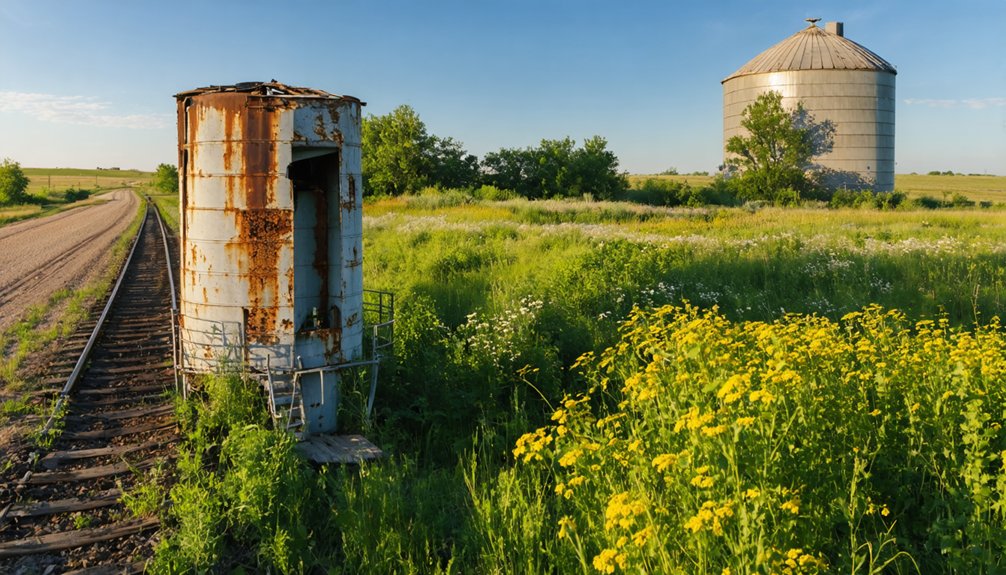
The site of the former town now stands as an unremarkable patch of private property 5.5 miles southeast of Iowa City.
You’ll find no standing structures, visible foundations, or markers commemorating Midway’s existence. The current site conditions reveal a landscape that’s been reclaimed by natural vegetation, with the land’s precise use undocumented in public records.
- There’s no public access to explore the grounds, as it’s privately owned with no designated parking or facilities.
- You won’t spot any remnants of streets, property lines, or building foundations on the surface.
- No historical markers or commemorative plaques exist to mark this ghost town’s location.
- The area remains mostly empty, possibly used for agriculture like much of rural Johnson County.
Like many rural Iowa communities that experienced decline, this area’s transformation from town to empty land reflects a common pattern of population loss seen in places like the unnamed town that dropped from 586 to 338 residents over a century.
Historical Legacy and Documentation
Despite limited historical records, Midway’s documented peak population of 597 residents in 1902 marks its significance as an early Johnson County settlement.
Though records are sparse, Midway’s 597 residents in 1902 highlight its importance in Johnson County’s early development.
You’ll find the town’s historical significance preserved in its geographic coordinates (41°37′08″N 91°26′21″W), located 5.5 miles southeast of Iowa City.
While specific details about daily life and community impact remain scarce, Midway’s story contributes to Iowa’s broader ghost town narrative.
Today, you can’t access the original townsite as it’s private property with no remaining structures.
Digital archives and local historical resources maintain what little documentation exists about this once-thriving community.
While preservation efforts continue for Iowa’s ghost towns generally, Midway’s legacy lives on primarily through historical listings and local discussions about Johnson County’s early settlements.
Frequently Asked Questions
Were There Any Notable Crimes or Mysterious Events in Midway’s History?
You won’t find documented unsolved mysteries or crime stories specific to Midway, though Iowa’s broader region holds numerous infamous cases like the Villisca Axe Murders in other rural communities.
What Native American Tribes Originally Inhabited the Midway Area?
Since time immemorial, you’d find the Meskwaki (Fox) tribe dominated the area’s cultural significance, with massive villages of 2,000 people along the Iowa River. The Ioway people also claimed ancestral ties here.
Did Any Famous People or Historical Figures Visit Midway?
You won’t find any documented Famous Visitors or Historical Events in Midway’s records. The town’s short-lived existence and limited documentation haven’t preserved any notable visits to this location.
What Were the Most Common Occupations of Midway’s Residents?
While you’d expect something exotic, farming dominated daily life. You’d find residents working agricultural practices around their land, while others ran small local businesses serving the community’s needs.
Were There Any Schools or Churches Established in Midway?
You’ll find limited concrete evidence of school history or church affiliations in Midway, though with 597 residents in 1902, it’s likely the town had basic educational and religious institutions.
References
- https://www.wikiwand.com/en/articles/Midway
- https://en.wikipedia.org/wiki/Midway
- https://kids.kiddle.co/List_of_ghost_towns_in_Iowa
- https://ouriowaheritage.com/jc-ghost-towns/
- https://www.press-citizen.com/story/opinion/2022/04/01/opinion-like-anything-else-small-iowa-towns-can-also-die-neglect-jacqueline-smetak/7172198001/
- https://pubs.lib.uiowa.edu/annals-of-iowa/article/7045/galley/115796/view/
- https://pubs.lib.uiowa.edu/annals-of-iowa/article/id/13329/download/pdf/
- https://en.wikipedia.org/wiki/Category:Ghost_towns_in_Iowa
- https://www.nps.gov/places/johnson-county-poor-farm-and-asylum-historic-district.htm
- https://www.johnsoncountyiowa.gov/about
